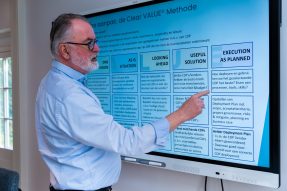How we work: The Clear VALUE Method™
Using the Clear VALUE Method™, we will help you find the right strategies and solutions for your company in 5 consecutive steps. This method was developed in 2013 by Frans Melenhorst and has been optimized ever since. It has been successfully used and deployed at many of our customers, leading to the adoption of a customer-centric and data-driven way of working within the entire company. Moreover, the Clear VALUE Method™ unveils relevant use cases and requirements which enables the business to achieve, and exceed, its goals and ambitions.

1 Vision
The basic question is: where do you want your company to be in 2-3 years? What are your ambitions, goals and strategy? What are your barriers to this? And: how can customer data help you achieve this? We start with a Vision document that bridges the gap between company ambitions and goals and the use of customer data.
The Vision document shows how you can grow in number of customers, customer turnover and profit and what is required for this. We explain how customer data can help with this and whether it makes sense to put all data in one data platform (a Customer Data Platform). Or not.
To this end, we hold discussions with both the management and the various departments, we collect information about your market and translate it for your company. With the Vision Document you know what you can do with a Customer Data Platform (CDP), the value and the risks. This puts the entire company on the same page.
We often hear from customers: “Yes, if you put it that way, it is strange that we are not doing it yet.”
2 What is the “As is” situation?
Together with the management and other stakeholders, we look at the customer journeys: what data do you need to be able to steer properly? Each discipline contributes from its own professional knowledge, and we fill in what that means from a customer-oriented way of thinking and working.
Thanks to this approach, it soon becomes logical, for example, to send a message to customers at a certain time that something is ready for them, or a booking confirmation. But this also reveals gaps or duplications in customer management.
We then add what you already have in terms of data, communication channels, processes, tools and skills; what do you have and what can you already do?
A customer asked us for advice to help select a CDP. The first step already showed that Marketing and Sales partly performed each other’s work instead of working closely together: Marketing sold products and Sales sent promotional emails to customers, so they worked at cross purposes. We then drew up the customer journey with both departments for an overview of the process. Each department looked at the needs of the customer from the perspective of its own task. It turned out that their existing system could already provide the necessary data – so a new system was no longer necessary.
3 Looking Ahead: what is required?
Based on the results from the Vision Document and the assessment of the “As Is” situation, we then determine what is required. At the moment it may appear that the required data is recorded in different sources, which makes a CDP interesting.
The core functionality of a CDP is to unify customer data. If you want to make a good offer to customers or want to build a better store, you have to combine those data to create relevant insights. A CDP does what many marketers now do manually: merge data, cleanse data, and use it across multiple touch points. The CDP quickly provides complete and reliable data for omnichannel personalization and trigger-based marketing.
It’s not about separate promotions, but about the basic reason why people want to shop with you: a good range in the area with pleasant staff. Because a good store deserves loyalty.
In this phase we identify the requirements and wishes for your data storage, for the tools to make analyses and reports, for the skills of your team and what you can improve on the customer journey to steer on data so that you achieve your business goals. We define this in a compact Requirements document.
4 Useful solutions: not the best or most elaborate, but the ones that are fit for purpose
With the Requirements document, and with our knowledge and experience, we go to various suppliers and arrive at a longlist. We discuss these in order to arrive at a shortlist of three to five solutions. We invite those parties with a request for proposal, for a demonstration and a presentation. We again add our information and our experiences with that of the suppliers. From the shortlist, we finally choose the solutions that best meet the requirements and wishes of our client. We also make the business case, so that we also know whether the solution pays off financially.
5 Execution as planned: step by step and first time right
Together with the vendor and your team, we implement the chosen solution for your company and help you develop the first metrics, the first customer insights and the first customer engagement campaigns. For this, we draw up our Deployment Plan and carry out the project. You name the acceptance criteria: when are you satisfied? We make a risk analysis: what risks are there, how big are they and what is the solution if it really happens? The result is a well-implemented solution as a basis for steering on customer data to achieve your long-term goals.
We prefer to work agile, for optimum flexibility. We work step by step and always deliver intermediate results of something that works. We always test these against your criteria, our experience and the Vision document.
Get to know us better
Let us tell you how we can support you. Call, mail or whatsapp us and get to know us.
Contact us

